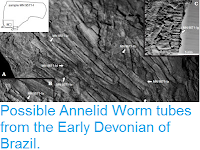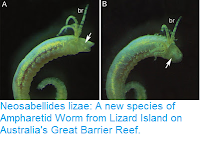Bristle Worms, Terebellida, are predominantly marine Polychaete Worms which live in tubes on the seafloor and feed on detritus. Members of the genus Neoamphitrite usually have distinct lateral lobes on anterior segments, three pairs of dichotomous branchiae, distally hirsute notochaetae, and the uncini beginning at segment 5. To date, 12 species of Neoamphitrite are known, of which three, Neoamphitrite edwardsi, Neoamphitrite ramosissima, and Neoamphitrite vigintipes, have been recorded from East Asia.
In a paper published in the journal ZooKeys on 22 June 2020, Hyun Ki Choi of the South Korean National Institute of Biological Resources, Hana Kim of the National Marine Biodiversity Institute of Korea, and Seong Myeong Yoon of the Department of Biology at Chosun University, describe a new species of Neoamphitrite from the Sea of Japan.
The new species is named Neoamphitrite undevigintipes, which is a combination of the Latin 'undeviginti' meaning 'nineteen' and 'pes' meaning 'foot'; thus this name means ‘nineteen feet’, referring to the 19 pairs of notopodia on the thoracic segments. In Neoamphitrite taxonomy, the number of notopodia is a key character for the identification of species. The species is described from 22 specimens collected from the Sea of Japan at depths of between 500 and 1000 m off the east coast of South Korea.
Neoamphitrite undevigintipes, paratype (MABIKNA00156356), lateral view. Scale bar: 1.0 cm. Choi et al. (2020).
The holotype of Neoamphitrite undevigintipes is complete, 11.0 cm long, 1.5 cm wide at segments 10, and with approximately 74 segments. The body uniformly light beige in alcohol, without pigmentation pattern, and consist of a thorax with 19 chaetigers and an abdomen. The anterior thoracic segments are compact until about 13 and the subsequent segments are slightly narrower and longer than the 13 anterior segments. The tentacular lobe is short and collarlike. The peristomium has a fleshy ridge on the ventral side, separated anteriorly from the lower lip by a groove. Upper lip distinct and undulate witha free margin. The lower lip is well-developed, and projects forward. The buccal tentacles are filiform with ventral grooves. Lateral lappets are paired on segments 2–4, distinct thickness flaps, protrude forwards, with weakly developed glandular margin; the first and second lappets are well-developed, but the third lappets are reduced in length, and located on the nearby base of notopodia. Branchiae paired on segments 2–4, dichotomous, with 3 tiers of branches and weakly annulated stalk distinct. The nephridial papillae small, oval, present on segments 3–15, and located between noto- and neuropodia; those with fused tube retracted into body on segments 6–8 and other with free tube distinctly projecting from the body. The ventral shields are trapezoidal, broader than longer, present on segments 3–14; first shield on segment 3 with glandular margin and others with smooth margin; thereafter shields replaced by mid-ventral groove extending to pygidium. The notopodia are short, rectangular, present on segments 4–22 (chaetigers 1–19); last 2 or 3 pairs becoming much shorter. The notochaetae slightly curved, medially winged and distally serrated, types of 2 lengths; chaetae on anterior row at least half as long as those on the posterior row. Neuropodia begin from segment 5 as low rectangular ridges, and with uncini arranged in single rows on segments 5–10 (chaetigers 2–7), uncini in double rows beak to beak arrangement on segments 11–22 (chaetigers 8–19), and in single row on all abdominal segments. The uncini are avicular, short-handled with short triangular heel, distally pointed prow, minute dorsal button, and 5 rows of secondary teeth on main fang with subrostral guard.
Neoamphitrite undevigintipes. (A) Paratype (MABIKNA00156357) (B) paratype (MABIKNA00156358) (C) (MBIKINA00156359) (D)–(H) (MABIKNA00156360). (A) Anterior end, lateral view (B) anterior end, ventral view (C) notopodial uncinus, lateral view (D) uncini arranged in double rows (E) thorax with 19 notopodia (F) last thoracic segment with uncini arranged in double rows and first abdominal segment with uncini arranged in single row (G) notochaetae (H) distal region of notochaetae. Scale bars: 1.0 mm (A), (B), 0.025 mm (C), (D), 5.0 mm (E), 0.5 mm (F), 0.1 mm (G), 0.025 mm (H). Abbreviations: fr, nephridial papillae with free tube; fu, nephridial papillae with fused tube. Choi et al. (2020).
See also...
Follow Sciency Thoughts on Facebook.








